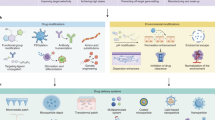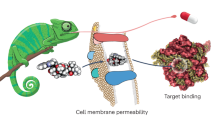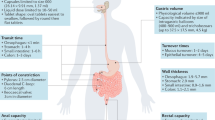Abstract
Prodrugs are derivatives with superior properties compared with the parent active pharmaceutical ingredient (API), which undergo biotransformation after administration to generate the API in situ. Although sharing this general characteristic, prodrugs encompass a wide range of different chemical structures, therapeutic indications and properties. Here we provide the first holistic analysis of the current landscape of approved prodrugs using cheminformatics and data science approaches to reveal trends in prodrug development. We highlight rationales that underlie prodrug design, their indications, mechanisms of API release, the chemistry of promoieties added to APIs to form prodrugs and the market impact of prodrugs. On the basis of this analysis, we discuss strengths and limitations of current prodrug approaches and suggest areas for future development.
This is a preview of subscription content, access via your institution
Access options
Access Nature and 54 other Nature Portfolio journals
Get Nature+, our best-value online-access subscription
$29.99 / 30 days
cancel any time
Subscribe to this journal
Receive 12 print issues and online access
$209.00 per year
only $17.42 per issue
Buy this article
- Purchase on Springer Link
- Instant access to full article PDF
Prices may be subject to local taxes which are calculated during checkout




Similar content being viewed by others
References
Rautio, J., Meanwell, N. A., Di, L. & Hageman, M. J. The expanding role of prodrugs in contemporary drug design and development. Nat. Rev. Drug Discov. 17, 559–587 (2018).
Mitchell, M. J. et al. Engineering precision nanoparticles for drug delivery. Nat. Rev. Drug Discov. 20, 101–124 (2021).
Narang, A. S. & Boddu, S. H. S. in Excipient Applications in Formulation Design and Drug Delivery (eds Narang, A. S. & Boddu, S. H. S) 1–10 (Springer, 2015).
Zhao, Z., Ukidve, A., Kim, J. & Mitragotri, S. Targeting strategies for tissue-specific drug delivery. Cell 181, 151–167 (2020).
Elsharkasy, O. M. et al. Extracellular vesicles as drug delivery systems: why and how? Adv. Drug Deliv. Rev. 159, 332–343 (2020).
Huttunen, K. M., Raunio, H. & Rautio, J. Prodrugs—from serendipity to rational design. Pharmacol. Rev. 63, 750–771 (2011).
Najjar, A. & Karaman, R. The prodrug approach in the era of drug design. Expert Opin. Drug. Deliv. 16, 1–5 (2018).
Jordheim, L. P., Durantel, D., Zoulim, F. & Dumontet, C. Advances in the development of nucleoside and nucleotide analogues for cancer and viral diseases. Nat. Rev. Drug Discov. 12, 447–464 (2013).
Wang, Y. et al. Therapeutic target database 2020: enriched resource for facilitating research and early development of targeted therapeutics. Nucleic Acids Res. 48, D1031–D1041 (2020).
Degtyarenko, K. et al. ChEBI: a database and ontology for chemical entities of biological interest. Nucleic Acids Res. 36, D344–D350 (2007).
Mullard, A. 2022 FDA approvals. Nat. Rev. Drug Discov. 22, 83–88 (2023).
Mullard, A. 2021 FDA approvals. Nat. Rev. Drug Discov. 21, 83–98 (2022).
Mullard, A. 2020 FDA drug approvals. Nat. Rev. Drug Discov. 20, 85–91 (2021).
Mullard, A. 2019 FDA drug approvals. Nat. Rev. Drug Discov. 19, 79–84 (2020).
Wishart, D. S. et al. DrugBank 5.0: a major update to the DrugBank database for 2018. Nucleic Acids Res. 46, D1074–D1082 (2018).
Zhou, Y. et al. Therapeutic target database update 2022: facilitating drug discovery with enriched comparative data of targeted agents. Nucleic Acids Res. 50, D1398–D1407 (2022).
Sugawara, M. et al. Transport of valganciclovir, a ganciclovir prodrug, via peptide transporters PEPT1 and PEPT2. J. Pharm. Sci. 89, 781–789 (2000).
Peppercorn, M. A. Sulfasalazine: pharmacology, clinical use, toxicity, and related new drug development. Ann. Intern. Med. 101, 377–386 (1984).
Asaki, T. et al. Selexipag: an oral and selective IP prostacyclin receptor agonist for the treatment of pulmonary arterial hypertension. J. Med. Chem. 58, 7128–7137 (2015).
Lee, W. A. & Cheng, A. K. Tenofovir alafenamide fumarate. Antivir. Ther. 27, 13596535211067600 (2022).
Jankovic, J. Dopamine depleters in the treatment of hyperkinetic movement disorders. Expert Opin. Pharmacother. 17, 2461–2470 (2016).
Reigner, B., Blesch, K. & Weidekamm, E. Clinical pharmacokinetics of capecitabine. Clin. Pharmacokinet. 40, 85–104 (2001).
Aljuffali, I. A., Lin, C.-F., Chen, C.-H. & Fang, J.-Y. The codrug approach for facilitating drug delivery and bioactivity. Expert Opin. Drug Deliv. 13, 1311–1325 (2016).
Friedel, H. A., Campoli-Richards, D. M. & Goa, K. L. Sultamicillin. Drugs 37, 491–522 (1989).
Mueller, C. E. Prodrug approaches for enhancing the bioavailability of drugs with low solubility. Chem. Biodivers. 6, 2071–2083 (2009).
Barlow, N., Chalmers, D. K., Williams-Noonan, B. J., Thompson, P. E. & Norton, R. S. Improving membrane permeation in the beyond rule-of-five space by using prodrugs to mask hydrogen bond donors. ACS Chem. Biol. 15, 2070–2078 (2020).
Murakami, T. A minireview: usefulness of transporter-targeted prodrugs in enhancing membrane permeability. J. Pharm. Sci. 105, 2515–2526 (2016).
Camp, D., Garavelas, A. & Campitelli, M. Analysis of physicochemical properties for drugs of natural origin. J. Nat. Prod. 78, 1370–1382 (2015).
Hall, B. S. & Wilkinson, S. R. Activation of benznidazole by trypanosomal type I nitroreductases results in glyoxal formation. Antimicrob. Agents Chemother. 56, 115–123 (2012).
Jubeh, B., Breijyeh, Z. & Karaman, R. Antibacterial prodrugs to overcome bacterial resistance. Molecules 25, 1543 (2020).
Lin, D. et al. Bacterial-based cancer therapy: an emerging toolbox for targeted drug/gene delivery. Biomaterials 277, 121124 (2021).
Li, Y., Zhao, L. & Li, X.-F. Targeting hypoxia: hypoxia-activated prodrugs in cancer therapy. Front. Oncol. 11, 700407 (2021).
Peiró Cadahía, J., Previtali, V., Troelsen, N. S. & Clausen, M. H. Prodrug strategies for targeted therapy triggered by reactive oxygen species. Medchemcomm 10, 1531–1549 (2019).
Padilla, A. M. et al. Discovery of an orally active benzoxaborole prodrug effective in the treatment of Chagas disease in non-human primates. Nat. Microbiol. 7, 1536–1546 (2022).
Cundy, K. C. et al. XP13512 [(±)-1-([(α-Isobutanoyloxyethoxy) carbonyl] aminomethyl)-1-cyclohexane acetic acid], a novel gabapentin prodrug: I. Design, synthesis, enzymatic conversion to gabapentin, and transport by intestinal solute transporters. J. Pharmacol. Exp. Ther. 311, 315–323 (2004).
Salem, A. H. et al. Expanding the repertoire for “Large small molecules”: prodrug abbv-167 efficiently converts to venetoclax with reduced food effect in healthy volunteers. Mol. Cancer Ther. 20, 999–1008 (2021).
Halpern, L. The transfer of inorganic phosphorus across the red blood cell membrane. J. Biol. Chem. 114, 747–770 (1936).
Wiemer, A. J. Metabolic efficacy of phosphate prodrugs and the remdesivir paradigm. ACS Pharmacol. Transl. Sci. 3, 613–626 (2020).
Ohwada, J. et al. Design, synthesis and antifungal activity of a novel water soluble prodrug of antifungal triazole. Bioorg. Med. Chem. Lett. 13, 191–196 (2003).
Sawada, S. et al. Synthesis and antitumor activity of 20 (S)-camptothecin derivatives: Carbamate-linked, water-soluble derivaties of 7-ethyl-10-hydroxycamptothecin. Chem. Pharm. Bull. 39, 1446–1454 (1991).
Ensink, J. M. et al. Oral bioavailability and in vitro stability of pivampicillin, bacampicillin, talampicillin, and ampicillin in horses. Am. J. Vet. Res. 57, 1021–1024 (1996).
Sloane, J. L. et al. Prodrugs of PKC modulators show enhanced HIV latency reversal and an expanded therapeutic window. Proc. Natl Acad. Sci. USA 117, 10688–10698 (2020).
Citrome, L. Breakthrough drugs for the interface between psychiatry and neurology. Int. J. Clin. Pract. 70, 298–299 (2016).
Eddy, N. B., Halbach, H. & Braenden, O. J. Synthetic substances with morphine-like effect: clinical experience: potency, side-effects, addiction liability. Bull. World Health Organ. 17, 569 (1957).
Crews, K. R. et al. Clinical Pharmacogenetics Implementation Consortium (CPIC) guidelines for codeine therapy in the context of cytochrome P450 2D6 (CYP2D6) genotype. Clin. Pharmacol. Ther. 91, 321–326 (2012).
Klous, M. G., Van den Brink, W., Van Ree, J. M. & Beijnen, J. H. Development of pharmaceutical heroin preparations for medical co-prescription to opioid dependent patients. Drug Alcohol Depend. 80, 283–295 (2005).
Green, K. & DOWNS, S. J. Prednisolone phosphate penetration into and through the cornea. Invest. Ophthalmol. Vis. Sci. 13, 316–319 (1974).
Schijvens, A. M., ter Heine, R., de Wildt, S. N. & Schreuder, M. F. Pharmacology and pharmacogenetics of prednisone and prednisolone in patients with nephrotic syndrome. Pediatr. Nephrol. 34, 389–403 (2019).
Ishikawa, T. Chemotherapy with enteric-coated tegafur/uracil for advanced hepatocellular carcinoma. World J. Gastroenterol. 14, 2797 (2008).
Diasio, R. B., Bennett, J. E. & Myers, C. E. Mode of action of 5-fluorocytosine. Biochem. Pharmacol. 27, 703–707 (1978).
Fryklund, J., Gedda, K. & Wallmark, B. Specific labelling of gastric H+,K+-ATPase by omeprazole. Biochem. Pharmacol. 37, 2543–2549 (1988).
Khan, A. K. A., Piris, J. & Truelove, S. C. An experiment to determine the active therapeutic moiety of sulphasalazine. Lancet 310, 892–895 (1977).
Meyers, S., Sachar, D. B., Present, D. H. & Janowitz, H. D. Olsalazine sodium in the treatment of ulcerative colitis among patients intolerant of sulfasalazine: a prospective, randomized placebo-controlled, double-blind, dose-ranging clinical trial. Gastroenterology 93, 1255–1262 (1987).
Green, J. R. B. et al. Balsalazide is more effective and better tolerated than mesalamine in the treatment of acute ulcerative colitis. Gastroenterology 114, 15–22 (1998).
Gillis, J. C. & Wiseman, L. R. Secnidazole. Drugs 51, 621–638 (1996).
Kim, I. et al. Identification of a human valacyclovirase: biphenyl hydrolase-like protein as valacyclovir hydrolase. J. Biol. Chem. 278, 25348–25356 (2003).
Sun, J., Dahan, A. & Amidon, G. L. Enhancing the intestinal absorption of molecules containing the polar guanidino functionality: a double-targeted prodrug approach. J. Med. Chem. 53, 624–632 (2010).
Wang, T. et al. Discovery of the human immunodeficiency virus type 1 (HIV-1) attachment inhibitor temsavir and its phosphonooxymethyl prodrug fostemsavir. J. Med. Chem. 61, 6308–6327 (2018).
Kudo, S. & Ishizaki, T. Pharmacokinetics of haloperidol. Clin. Pharmacokinet. 37, 435–456 (1999).
Daley‐Yates, P. T., Price, A. C., Sisson, J. R., Pereira, A. & Dallow, N. Beclomethasone dipropionate: absolute bioavailability, pharmacokinetics and metabolism following intravenous, oral, intranasal and inhaled administration in man. Br. J. Clin. Pharmacol. 51, 400–409 (2001).
Chen, K.-J., Plaunt, A. J., Leifer, F. G., Kang, J. Y. & Cipolla, D. Recent advances in prodrug-based nanoparticle therapeutics. Eur. J. Pharm. Biopharm. 165, 219–243 (2021).
Reker, D. et al. Computationally guided high-throughput design of self-assembling drug nanoparticles. Nat. Nanotechnol. 16, 725–733 (2021).
Mauro, M. A., Murphy, K. P. J., Thomson, K. R., Venbrux, A. C. & Morgan, R. A. Image-Guided Interventions E-Book. Expert Radiology Series (Elsevier Health Sciences, 2020).
Rosen, L. S. et al. Phase 1 study of TLK286 (Telcyta) administered weekly in advanced malignancies. Clin. Cancer Res. 10, 3689–3698 (2004).
Gong, J., Yan, J., Forscher, C. & Hendifar, A. Aldoxorubicin: a tumor-targeted doxorubicin conjugate for relapsed or refractory soft tissue sarcomas. Drug Des. Dev. Ther. 12, 777 (2018).
Sitar, D. S. Clinical pharmacokinetics of bambuterol. Clin. Pharmacokinet. 31, 246–256 (1996).
Scheeren, T. W. L. Ceftobiprole medocaril in the treatment of hospital-acquired pneumonia. Future Microbiol. 10, 1913–1928 (2015).
Grygorenko, O. O. et al. Generating multibillion chemical space of readily accessible screening compounds. iScience 23, 101681 (2020).
Chen, C.-H. in Xenobiotic Metabolic Enzymes: Bioactivation and Antioxidant Defense 155–168 (Springer, 2020).
Beverage, J. N., Sissung, T. M., Sion, A. M., Danesi, R. & g, W. D. CYP2D6 polymorphisms and the impact on tamoxifen therapy. J. Pharm. Sci. 96, 2224–2231 (2007).
Krzyszczyk, P. et al. The growing role of precision and personalized medicine for cancer treatment. Technology 6, 79–100 (2018).
Baird, J. K. 8-Aminoquinoline therapy for latent malaria. Clin. Microbiol. Rev. 32, e00011-19 (2019).
Inturrisi, C. E. et al. Evidence from opiate binding studies that heroin acts through its metabolites. Life Sci. 33, 773–776 (1983).
Schmitt-Hoffmann, A. et al. Single-ascending-dose pharmacokinetics and safety of the novel broad-spectrum antifungal triazole BAL4815 after intravenous infusions (50, 100, and 200 milligrams) and oral administrations (100, 200, and 400 milligrams) of its prodrug, BAL8557, in healthy volunteers. Antimicrob. Agents Chemother. 50, 279–285 (2006).
Mackman, R. L. Phosphoramidate prodrugs continue to deliver, the journey of remdesivir (GS-5734) from RSV to SARS-CoV-2. ACS Med. Chem. Lett. 13, 338–347 (2022).
Jordan, V. C. Tamoxifen: a most unlikely pioneering medicine. Nat. Rev. Drug Discov. 2, 205–213 (2003).
Jordan, V. C., Collins, M. M., Rowsby, L. & Prestwich, G. A monohydroxylated metabolite of tamoxifen with potent antioestrogenic activity. J. Endocrinol. 75, 305–316 (1977).
Mickle, T., Guenther, S. & Chi, G. Methylphenidate-prodrugs, processes of making and using the same. US patent 10584112-B2 (2020).
O’Neill, J. I. M. Antimicrobial resistance: tackling a crisis for the health and wealth of nations. Review on Antimicrobial Resistance https://amr-review.org/sites/default/files/AMR%20Review%20Paper%20-%20Tackling%20a%20crisis%20for%20the%20health%20and%20wealth%20of%20nations_1.pdf (2014).
Evans, L. E. et al. Exploitation of antibiotic resistance as a novel drug target: development of a β-lactamase-activated antibacterial prodrug. J. Med. Chem. 62, 4411–4425 (2019).
Caradec, T. et al. A novel natural siderophore antibiotic conjugate reveals a chemical approach to macromolecule coupling. ACS Cent. Sci. 9, 2138–2149 (2023).
Peukert, C. et al. Siderophore conjugation with cleavable linkers boosts the potency of RNA polymerase inhibitors against multidrug-resistant E. coli. Chem. Sci. 14, 5490–5502 (2023).
Bodor, N., Shek, E. & Higuchi, T. Delivery of a quaternary pyridinium salt across the blood-brain barrier by its dihydropyridine derivative. Science 190, 155–156 (1975).
Bodor, N. & Simpkins, J. W. Redox delivery system for brain-specific, sustained release of dopamine. Science 221, 65–67 (1983).
Peauger, L. et al. Donepezil-based central acetylcholinesterase inhibitors by means of a “bio-oxidizable” prodrug strategy: design, synthesis, and in vitro biological evaluation. J. Med. Chem. 60, 5909–5926 (2017).
Daina, A., Michielin, O. & Zoete, V. SwissADME: a free web tool to evaluate pharmacokinetics, drug-likeness and medicinal chemistry friendliness of small molecules. Sci. Rep. 7, 42717 (2017).
Fralish, Z., Chen, A., Skaluba, P. & Reker, D. DeepDelta: predicting ADMET improvements of molecular derivatives with deep learning. J. Cheminform 15, 101 (2023).
Reker, D., Hoyt, E. A., Bernardes, G. J. L. & Rodrigues, T. Adaptive optimization of chemical reactions with minimal experimental information. Cell Rep. Phys. Sci. 1, 100247 (2020).
Schwaller, P. et al. Molecular transformer: a model for uncertainty-calibrated chemical reaction prediction. ACS Cent. Sci. 5, 1572–1583 (2019).
Coley, C. W. et al. A robotic platform for flow synthesis of organic compounds informed by AI planning. Science 365, eaax1566 (2019).
Zaretzki, J., Matlock, M. & Swamidass, S. J. XenoSite: accurately predicting CYP-mediated sites of metabolism with neural networks. J. Chem. Inf. Model. 53, 3373–3383 (2013).
de Bruyn Kops, C. et al. GLORY: generator of the structures of likely cytochrome P450 metabolites based on predicted sites of metabolism. Front. Chem. 7, 402 (2019).
Olsen, L., Montefiori, M., Tran, K. P. & Jørgensen, F. S. SMARTCyp 3.0: enhanced cytochrome P450 site-of-metabolism prediction server. Bioinformatics 35, 3174–3175 (2019).
Wishart, D. S. et al. BioTransformer 3.0—a web server for accurately predicting metabolic transformation products. Nucleic Acids Res. 50, W115–W123 (2022).
Šícho, M. et al. FAME 3: predicting the sites of metabolism in synthetic compounds and natural products for phase 1 and phase 2 metabolic enzymes. J. Chem. Inf. Model. 59, 3400–3412 (2019).
Karaman, R., Dajani, K. K., Qtait, A. & Khamis, M. Prodrugs of acyclovir–a computational approach. Chem. Biol. Drug Des. 79, 819–834 (2012).
Markovic, M., Ben-Shabat, S. & Dahan, A. Computational simulations to guide enzyme-mediated prodrug activation. Int. J. Mol. Sci. 21, 3621 (2020).
Kim, S. et al. PubChem substance and compound databases. Nucleic Acids Res. 44, D1202–D1213 (2016).
Elia, J., Easley, C. & Kirkpatrick, P. Lisdexamfetamine dimesylate. Nat. Rev. Drug Discov. 6, 343–344 (2007).
Hung, A., Sinclair, M., Hemmersbach-Miller, M., Edmonston, D. & Wyatt, C. Prescribing rates and characteristics of recipients of tenofovir-containing regimens before and after market entry of tenofovir alafenamide. J. Manag. Care Spec. Pharm. 26, 1582–1588 (2020).
D’Angelo, A. B., Westmoreland, D. A., Carneiro, P. B., Johnson, J. & Grov, C. Why are patients switching from tenofovir disoproxil fumarate/emtricitabine (Truvada) to tenofovir alafenamide/emtricitabine (Descovy) for pre-exposure prophylaxis? AIDS Patient Care STDS 35, 327–334 (2021).
Urquhart, L. Top product forecasts for 2020. Nat. Rev. Drug Discov. 19, 86–87 (2020).
Urquhart, L. Top companies and drugs by sales in 2020. Nat. Rev. Drug Discov. 20, 253 (2021).
Urquhart, L. Top companies and drugs by sales in 2021. Nat. Rev. Drug Discov. 21, 251 (2022).
Urquhart, L. Top companies and drugs by sales in 2022. Nat. Rev. Drug Discov. 22, 260 (2023).
Cha, M. & Yu, F. Pharma’s first-to-market advantage. https://www.mckinsey.com/~/media/McKinsey/Industries/Pharmaceuticals%20and%20Medical%20Products/Our%20Insights/Pharmas%20first%20to%20market%20advantage/Pharmas%20first%20to%20market%20advantage.pdf (McKinsey & Co., 2014).
Orayj, K. & Lane, E. Patterns and determinants of prescribing for Parkinson’s disease: a systematic literature review. Parkinsons Dis. 2019, 9237181 (2019).
Acknowledgements
Z.F. is supported by the Department of Defense (DoD) through the National Defense Science & Engineering Graduate (NDSEG) Fellowship Program. P.Z. acknowledges the support of NIAID grants AI139216 and AI152896. D.R. acknowledges the support of NIGMS grant R35GM151255.
Author information
Authors and Affiliations
Contributions
All authors made a substantial, direct and intellectual contribution to the work and approved it for publication.
Corresponding author
Ethics declarations
Competing interests
D.R. acts as a consultant to the pharmaceutical and biotechnology industry, as a mentor for Start2, and serves on the scientific advisory board of Areteia Therapeutics. S.K. is Chief Scientific Officer at Rivus. P.Z. is a scientific co-founder of Valanbio Therapeutics aiming at developing novel antibiotics.
Peer review
Peer review information
Nature Reviews Drug Discovery thanks Jarkko Rautio and the other, anonymous, reviewers for their contribution to the peer review of this work.
Additional information
Publisher’s note Springer Nature remains neutral with regard to jurisdictional claims in published maps and institutional affiliations.
Related links
ChEBI Database: https://www.ebi.ac.uk/chebi/
ClinCalc DrugStats Database: https://clincalc.com/DrugStats/
DrugBank: https://go.drugbank.com/
PubChem: https://pubchem.ncbi.nlm.nih.gov/
Therapeutic Target Database: https://idrblab.net/ttd/
Supplementary information
Rights and permissions
Springer Nature or its licensor (e.g. a society or other partner) holds exclusive rights to this article under a publishing agreement with the author(s) or other rightsholder(s); author self-archiving of the accepted manuscript version of this article is solely governed by the terms of such publishing agreement and applicable law.
About this article
Cite this article
Fralish, Z., Chen, A., Khan, S. et al. The landscape of small-molecule prodrugs. Nat Rev Drug Discov (2024). https://doi.org/10.1038/s41573-024-00914-7
Accepted:
Published:
DOI: https://doi.org/10.1038/s41573-024-00914-7



